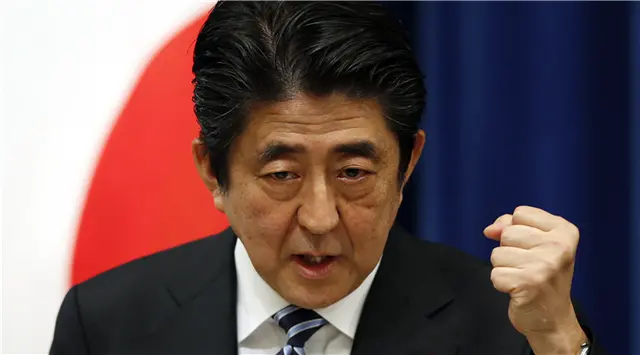Japanese Prime Minister Shinzo Abe on Thursday pledged to boost the number of foreign visitors to the disaster-hit region of Tohoku in the nation's northeast which was devastated by an earthquake-triggered tsunami five years ago, while maintaining that safety remained a priority for the controversial restarting of the nation's idled nuclear reactors from here on.
Speaking on the eve of the fifth anniversary of the Great East Japan earthquake, which struck east of the Oshika Peninsula of the Tohoku region of the country on March 11, 2011, and, together with an ensuing tsunami, killed nearly 16,000 people, injured more than 6,000 and left some 2,500 still unaccounted for, Abe told a press conference that his government will work towards tripling the numbers of tourists visiting the embattled region.
The prime minister said that part of the 2019 Rugby World Cup slated to be held in the Tohoku region ahead of Tokyo hosting the 2020 Summer Olympic and Paralympic Games, would contribute to the numbers of foreigners visiting the region. He said that while tourism in Japan had seen a significant uptick since his time in office, the Tohoku region was significantly lagging behind, having only just recovered to pre-disaster levels last year.
According to the latest reports, however, many parts of the northeast are still reeling in the wake of the multiple disasters, which also include Fukushima Prefecture and the ongoing nuclear crisis there, initially sparked by the massive earthquake-triggered tsunami knocking out the key cooling functions at the Daiichi nuclear power complex leading to multiple core meltdown in its reactors, resulting in the worst commercial nuclear disaster in history. Abe said his government will work towards creating much needed revenue for the battered region, including Fukushima, by upping visits by travelers three-fold to 1. 5 million by 2020.
Abe maintained that the reconstruction of the disaster-hit regions has been a "painful, day-to-day" process over the past five years that has proceeded "step by step," but noted that he believed that progress has been made. He added that the next five years would be a "reconstruction creation period" that would see more financial resources made available to help the affected areas return to normalcy.
Concerns have been voiced, however, by officials from within the Tohoku region, that spans some of the worst-hit prefectures in Japan's northeast, including Fukushima, Miyagi and Iwate Prefectures, that vital funds earmarked for essential revitalization work, including public housing projects to rehouse those still living in temporary shelters half a decade after the disasters, may be further delayed as priority is given to Olympic Games-related construction projects in the capital, despite significant delays to restoration work in the northeast prolonging the suffering of the still displaced locals there.
Following the nation's nerves being jangled by a Japanese district court a day earlier issuing Kansai Electric Power Co. with an injunction to stop the utility from operating two nuclear reactors at the Sea of Japan-facing Takahama plant, in Fukui Prefecture, which were among the first to be rebooted in the wake of the 2011 Fukushima crisis following enhanced safety checks, Abe said Thursday that safety remained a priority for the government.
The Otsu District Court gave the order to the utility citing "problematic points" and "questions remaining" over the power company's emergency response plans should a major accident occur such as a sizable tsunami, like the one that pummeled the Daiichi plant in Fukushima five years ago.
The district court said that the utility's evacuation measures and countermeasures to such an occurrence remained equivocal and ruled that the Takahama No. 3 and No. 4 reactors should be prevented from operating.
Kansai Electric Power Co. shut down the Takahama No. 3 reactor, which was only brought back on line in January this year, following the No. 4 reactor already being placed in cold shutdown on March 2 after an emergency alarm was triggered at the plant. The utility, prior to the injunction, was planning to bring the No. 4 reactor back online this month.
Abe maintained however that the government still plans to bring the nation's idled reactors back online, despite the latest setbacks, with strict safety standards in mind. He said the plants were essential to the nation's power needs as Japan is lacking in natural resources.
The Japan's premier added that while pushing ahead with its current nuclear policy, the government would continue to support Fukushima's ailing small and medium-sized businesses and ensure a "hands-on approach" by fortifying the current economic mechanisms in place. The premier also praised the workers at Tokyo Electric Power Co.'s (TEPCO) embattled Daiichi plant for their work towards the arduous and challenging process of eventually decommissioning the stricken plant and ongoing work to treat vast amounts of contaminated water being stored at the site.
The government's energy policy aims to see 20 percent of the nation's power being produced by nuclear means by 2030, as import costs for fossil fuels for turbine generators have and continue to stretch the state bank balance, and have raised environmental concerns as such power stations struggle to make up for supply deficits in resource-poor Japan.
But concerns, most recently in the form of protests from locals in Takahama on Thursday, and rising fears over the safety of the nation's aged reactors, punctuated by the ongoing situation in Fukushima, have seen pressure stepped up on the government by local municipalities, civic groups, legal teams and individuals, to scrap the use of nuclear power in favor of safer, renewable energy sources.
 简体中文
简体中文

